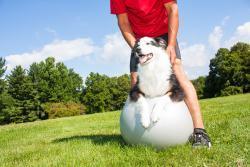Helping your dog with separation anxiety

The signs and tips to reducing dog separation anxiety
Dogs may be a man’s best friend, but they can be considerable sources of stress when exhibiting signs of separation anxiety. Alleviate your pup’s stress — and your own — by understanding the sources of separation anxiety and practical tips to reduce it.
Signs of Separation Anxiety
At our clinic, we often hear dog owners remarking, “He just seems so stressed out whenever I leave the house!” Dog anxiety manifests differently for each pet. However, common symptoms include:
- Frequent whining
- Incessant barking
- Excessive salivation
- Destruction of furniture or other items in the home
- Scratching at the walls or doors
- Urinating or defecating in the room
- Attempting to escape from a crate or room
Tips to Alleviate Dog Separation Anxiety
Fortunately, symptoms of separation anxiety can be reduced by providing a consistent environment with exercise, strong leadership, and good obedience. Our clinic recommends trying the following techniques to improve dog anxiety symptoms:
Provide Plenty of Exercise
 Particularly before leaving the house, take your dog for a brisk walk. This eliminates restless energy and leaves your pet in a calmer, resting mode when you leave the home. Providing food and water after the walk is a natural reward that keeps the dog more restful.
Particularly before leaving the house, take your dog for a brisk walk. This eliminates restless energy and leaves your pet in a calmer, resting mode when you leave the home. Providing food and water after the walk is a natural reward that keeps the dog more restful.
Signal that Leaving is No Big Deal
Without realizing it, you may be reinforcing bad behavior by providing attention to your dog before leaving or after returning home. Instead, try to normalize leaving the home. Do not offer touch, talk, or eye contact when leaving for the day or returning home.
Start Small
Reducing problem behaviors takes time. Start small, leaving for just five minutes at a time. Increase the time gradually, and soon you’ll be leaving for eight hours without trouble!
If you have a dog with separation anxiety, what is your most helpful tip?
